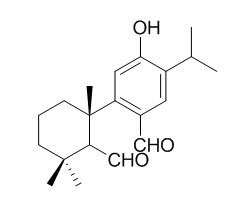Benzaldehyden
Benzaldehyde is an insecticidal, antimicrobial, and antioxidant compound, it could be applicable for developing novel insecticide for agriculture use. Oral Benzaldehyde exerts antiallergic effects in murine allergic asthma and rhinitis, possibly through inhibition of HIF-1α and VEGF.
Inquire / Order:
manager@chemfaces.com
Technical Inquiries:
service@chemfaces.com
Tel:
+86-27-84237783
Fax:
+86-27-84254680
Address:
1 Building, No. 83, CheCheng Rd., Wuhan Economic and Technological Development Zone, Wuhan, Hubei 430056, PRC
Providing storage is as stated on the product vial and the vial is kept tightly sealed, the product can be stored for up to
24 months(2-8C).
Wherever possible, you should prepare and use solutions on the same day. However, if you need to make up stock solutions in advance, we recommend that you store the solution as aliquots in tightly sealed vials at -20C. Generally, these will be useable for up to two weeks. Before use, and prior to opening the vial we recommend that you allow your product to equilibrate to room temperature for at least 1 hour.
Need more advice on solubility, usage and handling? Please email to: service@chemfaces.com
The packaging of the product may have turned upside down during transportation, resulting in the natural compounds adhering to the neck or cap of the vial. take the vial out of its packaging and gently shake to let the compounds fall to the bottom of the vial. for liquid products, centrifuge at 200-500 RPM to gather the liquid at the bottom of the vial. try to avoid loss or contamination during handling.
ACS Food Sci. Technol.2023, 3(2):273-282.
Plants (Basel).2020, 9(11):1422.
J Pharm Biomed Anal.2023, 234:115570.
PLoS One.2018, 13(4):e0195642
Cell Rep.2022, 39(1):110643.
Malaysian Journal of Analytical Sciences2023, 27(4):840-848.
Food Chem.2024, 458:140201.
J. of Agricultural Science2015, 1916-9760
Front Plant Sci.2022, 12:811166.
Inflammation2015, 38(1):445-55
Related and Featured Products
J Microbiol. 2015 Feb;53(2):127-33.
Benzaldehyde as an insecticidal, antimicrobial, and antioxidant compound produced by Photorhabdus temperata M1021.[Pubmed:
25626368 ]
METHODS AND RESULTS:
The analysis of (1)H and (13)C NMR spectra revealed the identity of pure compound as "Benzaldehyde". The Benzaldehyde showed insecticidal activity against G. mellonella in a dose-dependent manner and 100% insect mortality was observed at 108 h after injection of 8 mM Benzaldehyde. In a PO inhibition assay, 4, 6, and 8 mM concentrations of Benzaldehyde were found to inhibit PO activity about 15%, 42%, and 80% respectively. In addition, nodule formation was significantly (P < 0.05) inhibited by 4, 6, and 8 mM of Benzaldehyde as compare to control. Moreover, Benzaldehyde was found to have great antioxidant activity and maximum antioxidant activity was 52.9% at 8 mM Benzaldehyde as compare to control.
Antimicrobial activity was assessed by MIC values ranged from 6 mM 10 mM for bacterial strains and 8 mM to 10 mM for fungal strains.
CONCLUSIONS:
The results suggest that Benzaldehyde could be applicable for developing novel insecticide for agriculture use.
Int Immunopharmacol. 2014 Oct;22(2):444-50.
Benzaldehyde suppresses murine allergic asthma and rhinitis.[Pubmed:
25107441]
METHODS AND RESULTS:
To evaluate the antiallergic effects of oral Benzaldehyde in a murine model of allergic asthma and rhinitis, we divided 20 female BALB/c mice aged 8-10 weeks into nonallergic (intraperitoneally sensitized and intranasally challenged to normal saline), allergic (intraperitoneally sensitized and intranasally challenged to ovalbumin), and 200- and 400-mg/kg Benzaldehyde (allergic but treated) groups. The number of nose-scratching events in 10 min, levels of total and ovalbumin-specific IgE in serum, differential counts of inflammatory cells in bronchoalveolar lavage (BAL) fluid, titers of Th2 cytokines (IL-4, IL-5, IL-13) in BAL fluid, histopathologic findings of lung and nasal tissues, and expressions of proteins involved in apoptosis (Bcl-2, Bax, caspase-3), inflammation (COX-2), antioxidation (extracellular SOD, HO-1), and hypoxia (HIF-1α, VEGF) in lung tissue were evaluated. The treated mice had significantly fewer nose-scratching events, less inflammatory cell infiltration in lung and nasal tissues, and lower HIF-1α and VEGF expressions in lung tissue than the allergic group. The number of eosinophils and neutrophils and Th2 cytokine titers in BAL fluid significantly decreased after the treatment (P<0.05).
CONCLUSIONS:
These results imply that oral Benzaldehyde exerts antiallergic effects in murine allergic asthma and rhinitis, possibly through inhibition of HIF-1α and VEGF.



